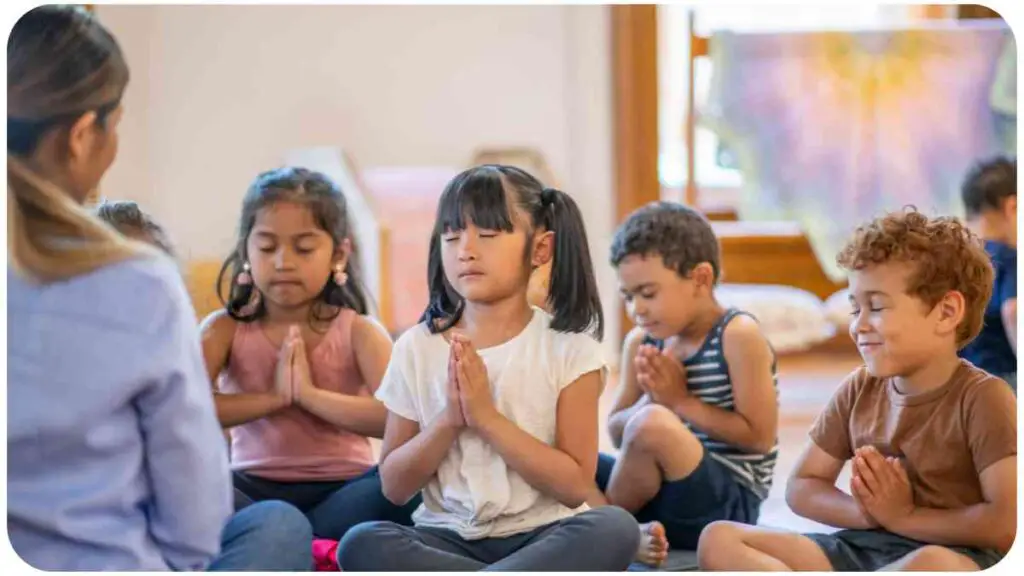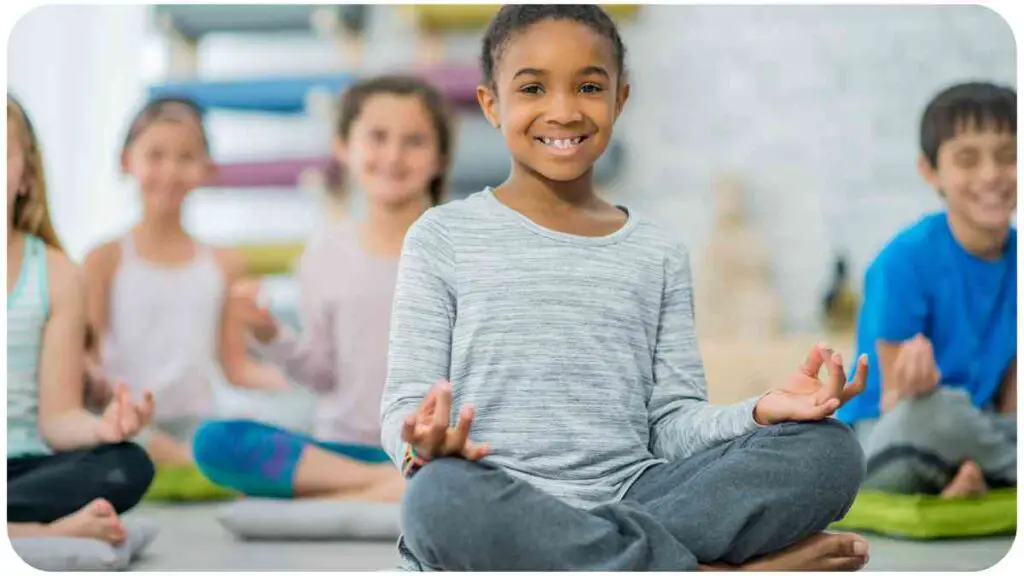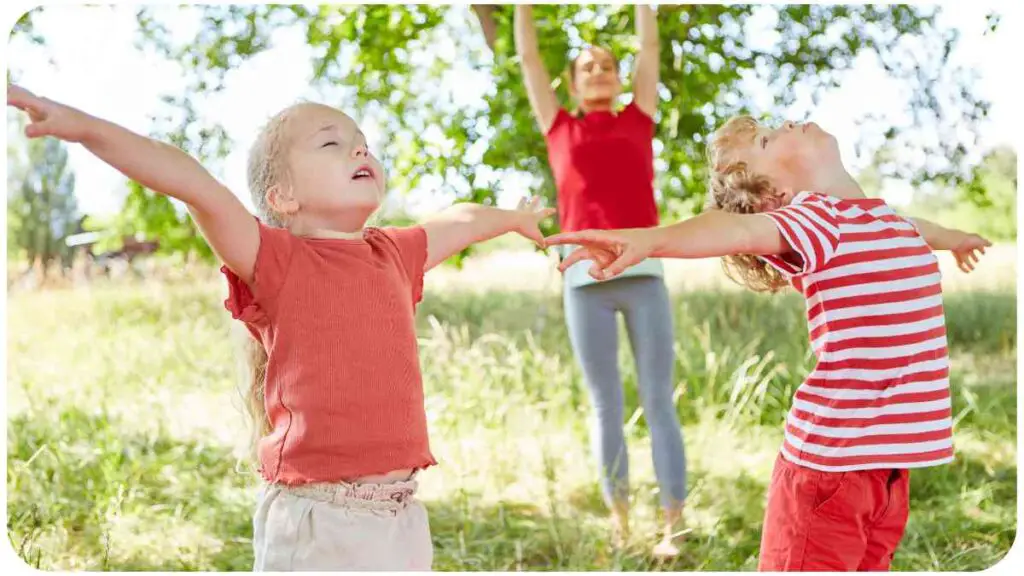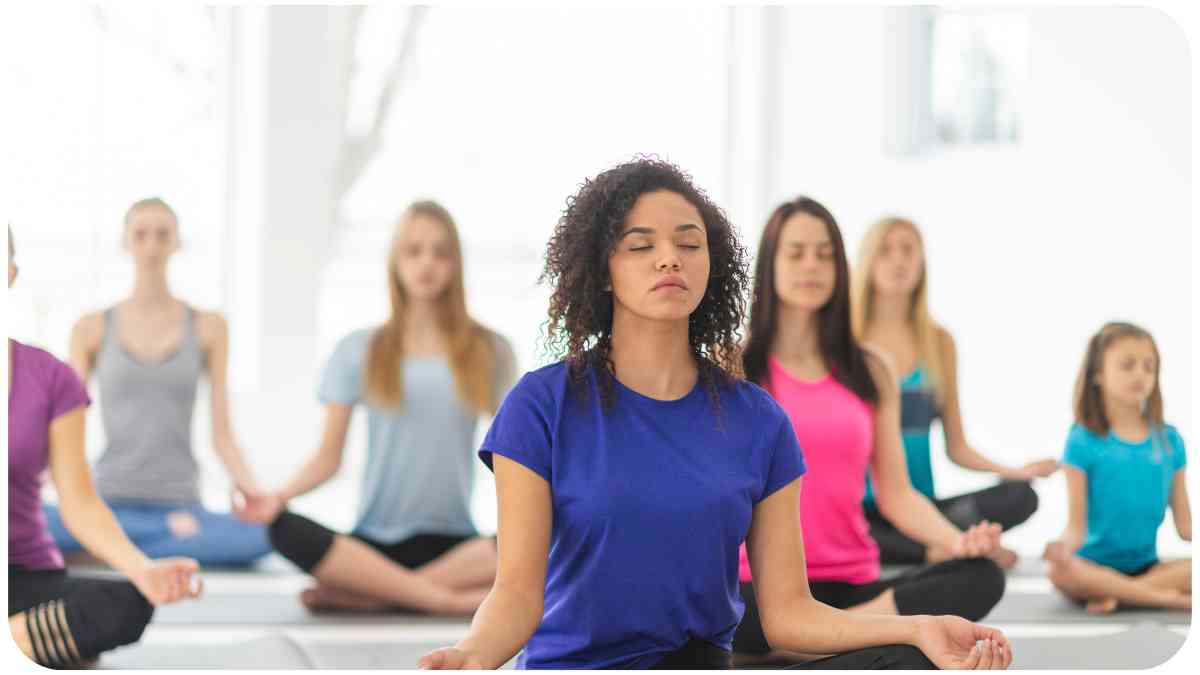Welcome to the world of easy, no-mat kids’ yoga flows that you can try right in the comfort of your home for free. In this guide, we’ll explore various poses, flows, and techniques specifically designed to make yoga fun and accessible for children.
Whether you’re a parent, teacher, or caregiver, these simple practices will help children build strength, flexibility, and mindfulness in a playful way.
| Takeaways |
|---|
| 1. Kids’ yoga offers holistic benefits for physical and mental well-being. |
| 2. Engage children with imaginative themes, partner poses, and interactive games. |
| 3. Safety is paramount – supervise sessions, encourage gentle movements, and use age-appropriate language. |
| 4. Breathing exercises play a crucial role – try Bunny Breath, Flower Breath, Snake Breath, and Hot Chocolate Breath. |
| 5. Regular practice is encouraged through routines, milestone celebrations, family sessions, and creative exploration. |
2. Benefits of Kids Yoga

Before diving into the yoga flows, let’s briefly discuss the incredible benefits of introducing yoga to children. From improved concentration to enhanced motor skills, yoga offers a holistic approach to physical and mental well-being in growing minds.
Introduce your little ones to the joy of yoga with these beginner yoga classes for children. Focused on stretching and mindful breathing, these classes foster a positive and healthy lifestyle from an early age.
3. Getting Started: Setting Up the Space
Creating the right environment is crucial for a successful kids’ yoga session. Find a quiet and clutter-free space with ample room for movement. Consider adding colorful mats or cushions to make the setting inviting and engaging.
4. Warm-Up Poses
Table: Warm-Up Poses Overview
| Pose Name | Description |
|---|---|
| Sun Salutation | A series of poses to energize the body |
| Butterfly Stretch | Opens up hips and improves flexibility |
| Cat-Cow Stretch | Warms up the spine for flexibility |
| Snake Pose | Stretches the abdominal muscles |
Now, let’s delve into each warm-up pose to kickstart your kids’ yoga session.
Sun Salutation:
Begin with the Sun Salutation to warm up various muscle groups and increase blood flow. Invite children to reach for the sky, bend down to touch their toes, and flow through the sequence with joy.
Butterfly Stretch:
Encourage kids to sit with their legs in a butterfly position, flapping their “wings” to open up their hips. This pose is excellent for promoting flexibility and a sense of freedom.
Cat-Cow Stretch:
Move into the Cat-Cow Stretch, where children arch their backs like a cat and then dip their spine down like a cow. This dynamic movement warms up the spine and promotes flexibility.
Snake Pose:
Finish the warm-up with the Snake Pose, where kids lie on their stomachs, lifting their upper body to strengthen the back muscles and stretch the abdomen.
Ignite your child’s imagination with creative visualizations during yoga. This guide takes young yogis on a journey, incorporating the magic of new moon-inspired practices for a fun and mindful experience.
5. Energizing Flows for Kids

Table: Energizing Flow Sequences
| Flow Name | Poses Included |
|---|---|
| Jungle Adventure Flow | Tree Pose, Lion’s Roar, Monkey Jumps |
| Superhero Power Flow | Mountain Pose, Warrior Pose, Superhero Flying Pose |
| Underwater Exploration | Fish Pose, Seated Forward Bend (boat), Shark Swim |
| Cosmic Journey Flow | Star Pose, Rocket Ship Pose, Galaxy Meditation |
Now, let’s explore these fun and energizing yoga flows that will captivate the imagination of the little yogis.
Jungle Adventure Flow:
Embark on a journey through the jungle with poses like Tree Pose, where kids stand tall like trees, Lion’s Roar to release energy, and Monkey Jumps to add an element of playfulness.
Superhero Power Flow:
Tap into the superhero within by practicing Mountain Pose, Warrior Pose, and the exciting Superhero Flying Pose. This flow not only boosts energy but also enhances balance and strength.
Underwater Exploration:
Dive deep into the ocean with Fish Pose, Seated Forward Bend (boat), and Shark Swim. This sequence encourages creativity and underwater-themed movement.
Cosmic Journey Flow:
Take a celestial adventure with Star Pose, Rocket Ship Pose, and a calming Galaxy Meditation. This flow is perfect for introducing mindfulness and imagination.
6. Calming Poses for Relaxation
Table: Calming Poses for Relaxation
| Pose Name | Description |
|---|---|
| Child’s Pose | Restful pose to release tension |
| Flower Pose | Encourages relaxation and focus |
| Sleeping Butterfly | Promotes calmness and gentle stretching |
| Resting Cloud Pose | Visualization pose for relaxation |
Now, let’s guide children into a state of calmness with these relaxing yoga poses.
Child’s Pose:
Begin the relaxation segment with Child’s Pose, where kids sit back on their heels, reaching their arms forward. This pose provides a sense of security and helps release tension.
Flower Pose:
Encourage focus and relaxation with Flower Pose. Children sit cross-legged, gently folding forward to mimic the unfolding petals of a flower.
Sleeping Butterfly:
Guide kids into a serene state with Sleeping Butterfly. In a seated position, they bring the soles of their feet together, allowing the knees to gently fall to the sides.
Resting Cloud Pose:
Finish the relaxation sequence with Resting Cloud Pose. Children lie on their backs, imagining they are floating on a cloud, fostering a sense of peace and tranquility.
7. Incorporating Fun Themes
Creating a themed yoga session adds an extra layer of excitement for kids. Whether it’s exploring the jungle, traveling to outer space, or diving into the ocean, infusing themes keeps the practice engaging and entertaining.
Transform stress into play with Frozen-themed kids yoga flows. These imaginative sequences blend beloved characters with yoga, providing a delightful and effective way for kids to unwind and embrace relaxation.
8. Partner Yoga for Parent-Child Bonding
Table: Partner Yoga Poses
| Pose Name | Description |
|---|---|
| Tree of Trust | Partner Tree Pose with shared balance |
| Seesaw Stretch | Forward bend with partners mirroring movement |
| Butterfly Connection | Partner Butterfly Pose for shared stretching |
| Mirror Image Meditation | Sitting back to back, mirroring breath and energy |
Now, let’s explore partner yoga poses that not only enhance flexibility but also strengthen the bond between parent and child.
Tree of Trust:
Stand side by side with your child, each placing the inside foot against the opposite leg for balance. Extend your arms, intertwining hands, creating a “Tree of Trust” with shared stability.
Seesaw Stretch:
Sit facing your partner, legs extended in a V shape. Lean forward, holding hands, and mirror each other’s movements for a delightful forward bend, resembling a seesaw in action.
Butterfly Connection:
Sit facing your partner, soles of the feet touching. Hold hands and gently flap your legs like butterfly wings. This pose promotes shared stretching and a sense of connection.
Mirror Image Meditation:
Sit back to back with your partner, mirroring each other’s posture. Close your eyes, synchronize your breath, and experience a calming meditation together.
9. Breathing Exercises for Kids

Table: Breathing Exercises Overview
| Exercise Name | Description |
|---|---|
| Bunny Breath | Quick, short breaths to energize |
| Flower Breath | Slow, deep breaths for relaxation |
| Snake Breath | Hissing breaths to release tension |
| Hot Chocolate Breath | Sipping breaths to warm up and calm |
Now, let’s introduce simple yet effective breathing exercises to help children manage their energy and emotions.
Bunny Breath:
Invite kids to take quick, short breaths through their noses, imitating the energetic hops of a bunny. This exercise is perfect for boosting alertness and vitality.
Help your child navigate anxiety with guided meditations. These relaxation techniques offer a soothing escape, promoting emotional well-being and mindfulness, guiding kids to a calmer and more centered state.
Flower Breath:
Guide children to take slow, deep breaths, imagining they are inhaling the fragrance of a beautiful flower. This exercise promotes relaxation and mindfulness.
Snake Breath:
Release tension with hissing breaths. Instruct kids to take a deep breath in and then exhale with a gentle hissing sound, mimicking the soothing rhythm of a snake.
Hot Chocolate Breath:
Wind down with Hot Chocolate Breath. Inhale as if taking a warm sip of hot chocolate, and exhale with a comforting sigh. This exercise helps calm the nervous system.
10. Yoga Games for a Playful Session
Table: Yoga Games Ideas
| Game Name | Description |
|---|---|
| Yoga Freeze | Musical statues with yoga poses |
| Mat Hopscotch | Classic hopscotch with yoga poses on each square |
| Pose Memory Match | Memory game matching cards with yoga poses |
| Yogi Simon Says | Classic Simon Says with a yoga twist |
Engage kids in a playful yoga session with these entertaining and educational yoga games.
Yoga Freeze:
Play music and encourage kids to move and groove with yoga poses. When the music stops, they must freeze in a yoga pose until the music resumes. This game promotes balance and focus.
Embark on imaginative Cosmic Kid Yoga Adventures with your little ones. This series combines storytelling and yoga, encouraging creativity and physical activity, making it an engaging and enriching experience for young minds.
Mat Hopscotch:
Transform the classic hopscotch game by assigning different yoga poses to each square. As children hop, they also practice the poses, adding a fun physical challenge to the game.
Pose Memory Match:
Create a memory match game with cards featuring yoga poses. Children take turns flipping cards to find matching pairs, all while learning and practicing various poses.
Yogi Simon Says:
Put a yoga twist on the classic Simon Says game. Call out yoga poses, and children must follow instructions only when preceded by “Yogi Simon Says.” This game encourages listening skills and coordination.
11. Addressing Common Concerns
When introducing kids to yoga, it’s natural to encounter common concerns or challenges. Let’s address a few and provide solutions to ensure a positive and enjoyable yoga experience for children.
Dealing with Restlessness:
If kids seem restless during the session, consider incorporating more dynamic and engaging poses. Use storytelling and imagination to make the practice captivating.
Overcoming Distractions:
In a home environment, distractions are inevitable. Create a dedicated space for yoga, minimize external disturbances, and make the practice visually appealing to keep kids focused.
Encouraging Participation:
Motivate reluctant participants by making yoga enjoyable. Use games, themes, and creative storytelling to capture their interest and enthusiasm.
Adjusting to Different Age Groups:
Tailor your yoga flows to suit different age groups. Younger children may enjoy more imaginative and playful poses, while older kids can explore a wider range of traditional yoga poses.
12. Tips for Teaching Kids Yoga Effectively
Teaching yoga to children requires a unique approach. Here are some tips to enhance your effectiveness as a kids’ yoga instructor:
Be Playful and Creative:
- Infuse playfulness and creativity into your sessions. Use imaginative stories, themes, and games to make yoga enjoyable.
Keep Sessions Short and Varied:
- Children have shorter attention spans. Keep sessions around 20-30 minutes and incorporate a variety of activities to maintain their interest.
Encourage Expression:
- Allow kids to express themselves through movement. Emphasize that there’s no right or wrong way to do a pose, fostering a non-judgmental environment.
Use Positive Reinforcement:
- Offer praise and positive reinforcement. Celebrate their efforts and achievements, boosting their confidence in the practice.
Incorporate Music and Props:
- Introduce music and props to enhance the sensory experience. Musical cues and colorful props can make the session more engaging.
13. Safety Precautions and Modifications
Ensuring the safety of children during yoga sessions is paramount. Here are some safety guidelines and modifications to consider:
Safety Guidelines
Supervision is Key:
- Always supervise children during yoga sessions, especially younger ones. Ensure that the practice area is free of potential hazards.
Emphasize Gentle Movements:
- Encourage gentle and controlled movements to prevent injuries. Remind children to listen to their bodies and not push themselves into uncomfortable positions.
Modify Poses as Needed:
- Be mindful of individual abilities and limitations. Offer modifications for poses to accommodate various skill levels and body types.
Use Age-Appropriate Language:
- Tailor your instructions to the age group you are working with. Use language that is easy to understand and follow.
Avoid Overstretching:
- Caution against overstretching. Emphasize the importance of a comfortable stretch without strain.
Respect Personal Space:
- Teach children to respect each other’s personal space during partner poses. Encourage communication and cooperation.
14. Encouraging Regular Practice
To foster a love for yoga in children, it’s essential to encourage regular practice. Here are some strategies:
Create a Routine:
- Establish a regular yoga routine, whether it’s a daily after-school session or a weekend family practice. Consistency helps make yoga a habit.
Celebrate Milestones:
- Celebrate achievements and milestones in their yoga practice. Whether it’s mastering a challenging pose or completing a full session, acknowledge their efforts.
Family Yoga Sessions:
- Make yoga a family affair. Organize family yoga sessions to create a shared experience and strengthen familial bonds.
Use Rewards and Incentives:
- Consider using a reward system to motivate children. Small incentives or a sticker chart can make the practice more enjoyable.
Explore New Themes Regularly:
- Keep the sessions exciting by introducing new themes or activities regularly. This prevents boredom and maintains interest.
16. Conclusion
Embarking on a journey of easy, no-mat kids’ yoga at home is not just beneficial but incredibly enjoyable for both children and adults. By incorporating creative themes, partner poses, and engaging games, you’re not only fostering physical well-being but also nurturing the imagination and emotional health of the little yogis.
Remember, the key is to make it fun, flexible, and adaptable to each child’s unique personality and abilities. As you guide them through these yoga flows, you’re not just teaching them poses; you’re instilling the foundations of a lifelong practice that promotes holistic well-being. So, roll out those imaginary mats, dive into the world of kids’ yoga, and let the adventure begin!
Further Reading
- “Kids Yoga Sequences That Keep Kids Engaged”: Explore engaging kids’ yoga sequences that captivate children’s attention and make the practice enjoyable. The article provides valuable insights into keeping kids actively involved in yoga.
- “Yoga for Kids: 16 Easy Yoga Poses Your Kids Can Totally Do”: Discover a collection of 16 easy yoga poses tailored for kids. This resource offers step-by-step guidance on poses that are both accessible and fun for children, fostering a love for yoga from an early age.
- “Kids Yoga Poses”: Delve into a variety of kids’ yoga poses designed to enhance flexibility, strength, and mindfulness. This comprehensive guide provides detailed descriptions and benefits for each pose, making it a valuable resource for parents, teachers, and yoga instructors.
FAQs
What are the benefits of introducing kids to yoga?
Introducing kids to yoga offers numerous benefits, including improved concentration, enhanced flexibility, and a holistic approach to physical and mental well-being.
How can I make kids’ yoga sessions more engaging?
To make kids’ yoga sessions more engaging, consider incorporating creative themes, partner poses, and interactive games. These elements add an element of playfulness to the practice.
Are there safety precautions I should take when teaching kids yoga?
Yes, ensuring the safety of children during yoga sessions is crucial. Always supervise, encourage gentle movements, and use age-appropriate language. Modify poses as needed to accommodate individual abilities.
What are some effective breathing exercises for kids during yoga?
Effective breathing exercises for kids during yoga include Bunny Breath for energy, Flower Breath for relaxation, Snake Breath for tension release, and Hot Chocolate Breath for calming the nervous system.
How can I encourage regular practice of yoga in children?
Encouraging regular practice in children involves creating a routine, celebrating milestones, organizing family yoga sessions, using rewards, and exploring new themes regularly to keep the sessions exciting and enjoyable.

Hello, my name is Hellen James! I am a yoga teacher and writer who loves to share information about how you can achieve a more fulfilling life. I have been practicing mindfulness, yoga, and meditation for over 10 years. My passion for these practices has led me to teach them to others.

